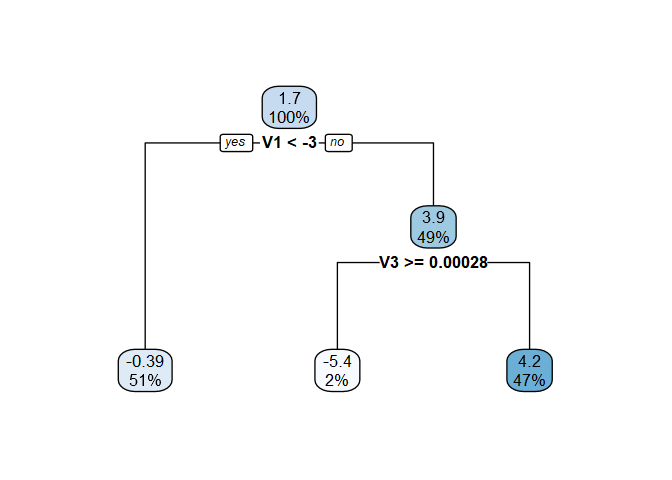The hardware and bandwidth for this mirror is donated by dogado GmbH, the Webhosting and Full Service-Cloud Provider. Check out our Wordpress Tutorial.
If you wish to report a bug, or if you are interested in having us mirror your free-software or open-source project, please feel free to contact us at mirror[@]dogado.de.
The goal of tehtuner is to implement methods to fit
models to detect and model treatment effect heterogeneity (TEH) while
controlling the Type-I error of falsely detecting a differential effect
when the conditional average treatment effect is uniform across the
study population.
Currently tehtuner supports Virtual Twins models (Foster
et al., 2011) for detecting TEH using the permutation procedure proposed
in (Wolf et al., 2022).
Virtual Twins is a two-step approach to detecting differential treatment effects. Subjects’ conditional average treatment effects (CATEs) are first estimated in Step 1 using a flexible model. Then, a simple and interpretable model is fit in Step 2 to model these estimated CATEs as a function of the covariates.
The Step 2 model is dependent on some tuning parameter. This parameter is selected to control the Type-I error rate by permuting the data under the null hypothesis of a constant treatment effect and identifying the minimal null penalty parameter (MNPP), which is the smallest penalty parameter that yields a Step 2 model with no covariate effects. The \(1-\alpha\) quantile of the distribution of is then used to fit the Step 2 model on the original data. In dong so, the Type-I error rate is controlled to be \(\alpha\).
tehtuner is available on CRAN; you can download the release
version with:
install.packages("tehtuner")You can download the development version from GitHub with:
# install.packages("devtools")
devtools::install_github("jackmwolf/tehtuner")We consider simulated data from a small clinical trial with 1000 subjects. Each subject has 10 measured covariates, 8 continuous and 2 binary. We are interested in estimating and understanding the CATE through Virtual Twins.
library(tehtuner)
data("tehtuner_example")We will consider a Virtual Twins model using a random forest to estimate the CATEs in Step 1 and then fitting a regression tree on the estimated CATEs in Step 2 with the Type-I error rate set at \(\alpha = 0.2\).
set.seed(100)
vt_cate <- tunevt(
data = tehtuner_example, Y = "Y", Trt = "Trt", step1 = "randomforest",
step2 = "rtree", alpha0 = 0.2, p_reps = 100, ntree = 50
)The fitted Step 2 model can be accessed via $vtmod. In
this case, as we used a regression tree in Step 2, our final model model
is of class rpart.object.
vt_cate$vtmod
#> n= 1000
#>
#> node), split, n, deviance, yval
#> * denotes terminal node
#>
#> 1) root 1000 18372.4300 1.6830340
#> 2) V1< -3.008541 511 5643.7030 -0.3942647 *
#> 3) V1>=-3.008541 489 8219.4140 3.8537890
#> 6) V3>=0.000282894 19 448.7299 -5.3806930 *
#> 7) V3< 0.000282894 470 6084.9480 4.2270980 *
rpart.plot::rpart.plot(vt_cate$vtmod, digits = -2)
The fitted model for the CATE is a function of the covariates
(V1, and V3), so we would conclude that there
is treatment effect heterogeneity at the 20% level.
We can also look at the null distribution of the MNPP through
vt_cate$theta_null. The 80th percentile of \(\hat\theta\) under the null hypothesis
is
quantile(vt_cate$theta_null, 0.8)
#> 80%
#> 0.07673669while the MNPP of our observed data is
vt_cate$mnpp
#> [1] 0.2454389The procedure fit the Step 2 model using the 80th quantile of the null distribution which resulted in a model that included covariates since the MNPP was above the 80th quantile.
#> Warning: Using `size` aesthetic for lines was deprecated in ggplot2 3.4.0.
#> ℹ Please use `linewidth` instead.
#> Warning: The dot-dot notation (`..density..`) was deprecated in ggplot2 3.4.0.
#> ℹ Please use `after_stat(density)` instead.
Development version 0.1.1.9001 added the
parallel option to tunevt() which allows the
user to perform the permutation procedure in parallel to reduce
computation times. Before doing so, you must register a parallel
backend; see ?foreach::foreach for more information.
For example, to carry out 100 permutations across 2 processors:
cl <- parallel::makeCluster(2)
doParallel::registerDoParallel(cl)
vt_cate_parallel <- tunevt(
data = tehtuner_example, Y = "Y", Trt = "Trt", step1 = "randomforest",
step2 = "rtree", alpha0 = 0.2, p_reps = 100, ntree = 50, parallel = TRUE
)
parallel::stopCluster(cl)Foster, J. C., Taylor, J. M., & Ruberg, S. J. (2011). Subgroup identification from randomized clinical trial data. Statistics in Medicine, 30(24), 2867–2880. https://doi.org/10.1002/sim.4322
Wolf, J. M., Koopmeiners, J. S., & Vock, D. M. (2022). A permutation procedure to detect heterogeneous treatment effects in randomized clinical trials while controlling the type-I error rate. Clinical Trials 19(5). https://doi.org/10.1177/17407745221095855
Deng C., Wolf J. M., Vock D. M., Carroll D. M., Hatsukami D. K., Leng N., & Koopmeiners J. S. (2023). “Practical guidance on modeling choices for the virtual twins method.” Journal of Biopharmaceutical Statistics. https://doi.org/10.1080/10543406.2023.2170404.
These binaries (installable software) and packages are in development.
They may not be fully stable and should be used with caution. We make no claims about them.
Health stats visible at Monitor.